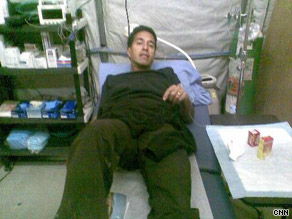| Topic: swine flu vaccine was bad then, and bad now (vid from '76) | |
|---|---|
|
http://www.dailymotion.com/video/x9mh9f_swine-flu-1976-propaganda_webcam
I'll never take the vaccine. |
|
|
|
|
|
your choice
but, if you catch the swine flu, I hope for the safety of me and my family that they quarantine you somewhere to prevent you from spreading it |
|
|
|
|
|
If the vaccine helps why not take it?

|
|
|
|
|
|
If the vaccine helps why not take it? 
cause some people see everything as a government conspiracy |
|
|
|
|
|
There is no proof that any vaccines are effective...
If the vaccine helps why not take it? 
|
|
|
|
|
|
Frankly, I had the swine flu (or my docs are 99% sure anyway). It was MISERABLE!!!!!!!!!! And it took weeks to recover fully. And I was kindly requested to stay the hell home, which I gladly did. I quarantined myself.
Not saying anyone should or shouldn't have the vaccine. Just saying. |
|
|
|
|
|
There are also health concerns with vaccines....I think I'll opt out myself and my boy out of this one. My other 2 boys are legal adults, they will decide for themselves.
|
|
|
|
|
|
Frankly, I had the swine flu (or my docs are 99% sure anyway). It was MISERABLE!!!!!!!!!! And it took weeks to recover fully. And I was kindly requested to stay the hell home, which I gladly did. I quarantined myself. Not saying anyone should or shouldn't have the vaccine. Just saying. I am glad you are better 
|
|
|
|
|
|
Frankly, I had the swine flu (or my docs are 99% sure anyway). It was MISERABLE!!!!!!!!!! And it took weeks to recover fully. And I was kindly requested to stay the hell home, which I gladly did. I quarantined myself. Not saying anyone should or shouldn't have the vaccine. Just saying. I am glad you are better 
It took a while    I will say, though, that while I never really felt like I was in danger or anything, it was one of the most miserable illnesses I've ever had, if not the worst. I will say, though, that while I never really felt like I was in danger or anything, it was one of the most miserable illnesses I've ever had, if not the worst.
|
|
|
|
|
|
There is no proof that any vaccines are effective... If the vaccine helps why not take it? 
What about Polio, etc? |
|
|
|
|
|
I went to Afghanistan and all I got was H1N1
Posted: 09:51 AM ET By Dr. Sanjay Gupta CNN Chief Medical Correspondent 
It started as a cough. It wasn’t the kind of cough where something is temporarily stuck in your throat. It wasn’t the kind of cough where simply clearing your throat would’ve been adequate. This was the kind of cough that hurts when you do it. A stinging pain that makes you wince and guard and hope that you don’t have to cough again any time soon. I thought I might have a fever, but of course, I was in the middle of covering a war in Afghanistan, and the conditions were… well, hot. So, maybe it was that. Problem was, the next day I wasn’t feeling any better – in fact, I was worse. I woke up in my dusty desert tent and tried to step out of my sleeping bag. Two steps later, I almost hit the deck. Incoming. Except this wasn’t due to any sirens going off, this was due to my own body simply being unable to hold myself up. I was lightheaded and freezing cold – even though it was over 100 degrees outside at that early hour of the morning. Dr. Sanjay Gupta, who contracted H1N1 in Afghanistan, receives treatment. I was nauseated and my entire body hurt. I tried to explain away my symptoms with lots of different excuses. You don’t sleep much while covering a war. My bulletproof jacket didn’t fit perfectly and was very heavy. There was a lot of dust and dirt, and maybe I had what the Marines referred to as the Kandahar Krud. It turned out to be none of those things. I remember looking over at my camera man, Scottie McWhinnie. He looked absolutely awful. He was wearing a scarf on his head, and it was completely drenched in sweat. He was coughing so loudly and frequently that I was really starting to worry about him – and about myself. We each had it, whatever “it” was. I made a command decision. As a physician reporter in a war zone, I was going to get us medical care. That prompted our visit to a battlefield hospital, not as reporters this time, but as patients. It is worth pointing out the irony of a medical reporter getting influenza type A, which was then ultimately confirmed as H1N1. (The term swine flu is a misnomer, as this strain is made up of several different components, including swine, but also avian parts.) It really didn’t matter if I got tested, as my doctor told me. It was the only flu strain circulating and I had it, and so did Scottie. We both had high fevers, the lack of appetite, terrible sinus congestion, body aches, and yes – that hacking, come out of the blue. I am not someone who gets sick, really ever. And this was the sickest I have ever been. I would’ve much preferred my own bed with all the comforts of home – including a wife who would’ve taken great pity on me and allowed me lots of rest and relaxation. Still, I am here to blog about it, after taking the requisite few days to stay at home and not spread my gift from Afghanistan to all my colleagues at work. In case you are curious, there wasn’t much the doctors could really do for me. Some Tylenol and a sinus decongestant (the same my wife would’ve given me). We also got IV fluids, given our inability to keep anything down. Within a couple days, I felt a lot better, and a few days after that – I was back to normal. It was a lot like… the flu – with a different name. A lot of people will get the exact symptoms I described above, and for most people, it will simply mean a few miserable days, hopefully spent in your home – and not in a war zone. Posted by: Dr. Sanjay Gupta - CNN Chief Medical Correspondent Story here |
|
|
|
|
|
on Aug. 13 the New York State Hospital Review and Planning Council adopted a regulation recommended by the New York State Health Department making approved annual influenza vaccinations mandatory, unless medically contraindicated, for health care workers in hospitals, outpatient clinics and home care services.
Questions about safety and claims of personal preference are understandable. Given the outstanding efficacy and safety record of approved influenza vaccines, our overriding concern then, as health care workers, should be the interests of our patients, not our own sensibilities about mandates. On this, the facts are very clear: the welfare of patients is, without any doubt, best served by the very high rates of staff immunity that can only be achieved with mandatory influenza vaccination – not the 40-50% rates of staff immunization historically achieved with even the most vigorous of voluntary programs. This is not the time for uninformed or self-interested parties to attempt to pump air into long-deflated arguments about vaccine safety in general or to use a single 33-year-old episode to deny decades of safety and saved lives achieved by influenza vaccines prepared in the same way as this year’s formulations. The seasonal influenza vaccine has completed, and before its approval the new H1N1 vaccine also underwent, the most careful development, production and testing processes leading scientists, clinicians and public health authorities can devise. Approval of the H1N1 vaccine was based on the application of the same scientific standards and methods that we believe should govern all our health care practices. We, as health care workers, owe it to our patients and to society in general to demonstrate our confidence in those scientific standards. Richard F. Daines, M.D. New York State Commissioner of Health |
|
|
|
|
|
Actually, many vaccines are incredibly effective and safe (such as polio, mentioned above. There is really no study anywhere that conclusively links vaccines with anything, except a drop in that disease's rates. I'm not saying there isn't some sort of cause/effect somewhere, but it's conjecture at this point.
People have to be able to weigh to their own satisfaction the risk/benefit and do what they feel is best for THEMSELVES and their families. Not everyone is going to have the same risk/benefit equation. |
|
|
|
|
|
Edited by
Quietman_2009
on
Thu 09/24/09 09:35 AM
|
|
|
foil will protect you from H1N1 flu

|
|
|
|
|
|
CDC study: Swine flu deaths higher in older kids
By MIKE STOBBE AP Medical Writer ATLANTA (AP) -- The first detailed study of U.S. children killed by swine flu found the outbreak differs from ordinary flu in at least one puzzling respect: It appears to be taking a higher toll on school-age youngsters than on babies and toddlers. At least 40 children have died, accounting for about one in 13 U.S. swine flu deaths, scientists with the Centers for Disease Control and Prevention said Thursday. Two-thirds of those already had high-risk health problems, confirming what officials have been saying about who is most vulnerable to swine flu. It is not clear whether the new virus is more dangerous than ordinary seasonal flu for kids, though some health officials suspect it is. But the analysis shows some preliminary and important differences: - Normally, half or more of the children who die of the flu are 4 and under. But more than 80 percent of the kids who died with swine flu were 5 through 17. Dr. Beth Bell, a CDC epidemiologist, said that may be because older children spend time at school and summer camp, exposed to more people than younger children kept at home. - Almost two-thirds of the children who died with swine flu had epilepsy, cerebral palsy or other neurodevelopmental conditions. In a previous flu season, only a third of the children who died had those conditions. - Other germs, working with swine flu in a one-two punch, were a big danger. A bacterial infection on top of the flu virus played a role in most of the deaths of otherwise healthy children. Swine flu was first identified in April and is now responsible for almost all flu cases in the United States. It has caused more than 1 million illnesses so far, though most were mild and not reported, the CDC estimates. More than 550 lab-confirmed deaths and 8,800 hospitalizations have been reported. Those statistics don't mean the new flu is worse than seasonal flu, which is particularly lethal to the elderly and plays a role in an estimated 36,000 deaths each year, the CDC says. But swine flu is causing more suffering in children and young adults than is customary, and a lot of parents are worried. Some emergency room doctors say they are seeing a lot of mildly ill children brought in by parents fearful that it is a swine flu case that will turn worse. Right now, cases are most common in the Southeast, possibly because schools are already in session, providing more opportunity for infections to spread, CDC officials said. However, there are no signs that the virus is mutating to become more deadly, as some scientists feared, CDC Director Thomas Frieden said. Each year 50 to 100 children die of seasonal flu. But it's hard to say whether children account for a higher proportion of deaths from swine flu than they do from seasonal flu. The CDC doesn't monitor seasonal flu deaths as closely as it does swine flu, and has no comprehensive count of each year's flu deaths to enable such a comparison. The new report focuses on 477 lab-confirmed swine flu deaths reported through Aug. 8. Thirty-six during that period were children. Only about 20 percent of those children were 4 or younger. That's unusual. Often, 50 percent or more of seasonal flu deaths are babies or toddlers, who have less mature immune systems and smaller airways, putting them in more danger from respiratory infections. Two-thirds of the children who died had high-risk medical conditions. Nearly all of them had an illness related to the nervous system, including mental retardation, cerebral palsy, epilepsy and other seizure disorders. Years ago experts recognized that children with neurodevelopmental conditions run a higher risk of serious complications from the flu. But the proportion of swine flu victims with that kind of underlying condition is high compared to a previous flu season, CDC officials said. It's not clear how significant that finding is, because many of the children had other medical problems besides the neurological conditions that had weakened their bodies, CDC officials said. Of 10 children who were healthy before they got swine flu, eight had a bacterial infection such as bacterial pneumonia along with the flu. http://hosted.ap.org/dynamic/stories/U/US_MED_SWINE_FLU_CHILDREN?SITE=MOSTP&SECTION=HOME&TEMPLATE=DEFAULT |
|
|
|
|
|
foil will protect you from H1N1 flu 
He looks crazeeeeeeeeeeeeee ... and the cat looks sad ... Yep, that does it! ... I'm stayin' in my bunker ... 
|
|
|
|
|
|
umm Polio was in decline, already......and look at what the good doctor testified before congress....
Jonas Salk, inventor of the IPV, testified before a Senate subcommittee that nearly all polio outbreaks since 1961 were caused by the oral polio vaccine. There is no proof that any vaccines are effective... If the vaccine helps why not take it? 
What about Polio, etc? |
|
|
|
|
|
Edited by
Quietman_2009
on
Thu 09/24/09 09:46 AM
|
|
|
umm Polio was in decline, already......and look at what the good doctor testified before congress.... Jonas Salk, inventor of the IPV, testified before a Senate subcommittee that nearly all polio outbreaks since 1961 were caused by the oral polio vaccine. There is no proof that any vaccines are effective... If the vaccine helps why not take it? 
What about Polio, etc? that was back when they used live viruses in the vaccine. They haven't done that in thirty years |
|
|
|
|
|
DPT vaccine, Tetanus, Hib, Hepatitis, Smallpox, MMR, etc.
Vaccines have done good. |
|
|
|
|
|
There is really no study anywhere that conclusively links vaccines with anything, except a drop in that disease's rates.
Ummmm, I beg to differ.....there are numerous studies Want a few? Dr. Michael Odent has written a letter in the JAMA (1994) where his figures show a five times higher rate of asthma in pertussis immunised children compared to non-immunised children. He is also quoted in the International Vaccination Newsletter (Sept. 1994): "Immunised children have more ear infections and spend more days in hospital." "Crib death" was so infrequent in the pre-vaccination era that it was not even mentioned in the statistics, but it started to climb in the 1950s with the spread of mass vaccination against diseases of childhood. --Harris L.Coulter, PhD. In the May 24, 1996, New Zealand Medical Journal, J. Barthelow Classen, MD, a former researcher at the U.S. National Institutes of Health (NIH) and the founder and CEO of Classen Immunotherapies in Baltimore, reported that juvenile diabetes increased 60 per cent following a massive hepatitis B vaccination campaign for babies six weeks or older in New Zealand from 1988 to 1991. In the October 22, 1997, Infectious Diseases in Clinical Practice, Classen showed that Finland's incidence of diabetes increased 147 per cent in children under five after three new vaccines were introduced in the 1970s, and that diabetes increased 40 per cent in children aged 5 to 9 after the addition of the MMR and Hib vaccines in the 1980s. He concluded that "the rise in IDDM [juvenile onset diabetes] in the different age groups correlated with the number of vaccines given." |
|
|
|
|












